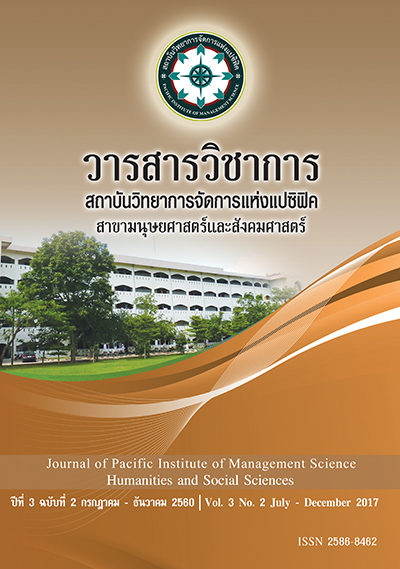(From CSR to CSR: Approaches to Sacriice for Social Beneits of the Business Sector)
Abstract
The approaches to making sacriice for social beneits of the business organization have been getting attention extensively since the 1990s. However, there are various forms of sacriice for social beneits, including the approach to corporate social responsibility (CSR) and creating shared value (CSV). This article aims to study the approaches to CSR and CSV through analyzing their characteristics of normative thinking and comparison of advantages. The study found that every forms of sacriice for social beneits can be applied for business and industrial organizations, depending on organizational leaders’ decision makings in selection of an appropriate form, types of business, budget, and internal as well as external environments of each organization.
References
สถาบันธุรกิจเพื่อสังคม ตลาดหลักทรัพย์แห่งประเทศไทย (2551) เข็มทิศธุรกิจเพื่อสังคม, กรุงเทพฯ : โรงพิมพ์ไอคอน พรินติ้ง.
สถาบันไทยพัฒน์ มูลนิธิบูรณะชนบทแห่งประเทศไทย ในพระบรมราชูปถัมภ์ (2560) ซีเอสอาร์คืออะไร, (สืบค้นเมื่อวันที่ 2 ตุลาคม 2560) <http://www.thaicsr.com/2006/03/blog-post_20.html>
โสภณ พรโชคชัย (2008) CSR: ทำดีเพี่อปกปิดความชั่ว, เผยแพร่โดยประชาไท, (สืบค้นเมื่อวันที่ 2 ตุลาคม 2560) <https:// prachatai.com/journal/2008/03/16013>
Blowield, Michael & Alan Murray (2011) Corporate Responsibility, Oxford: Oxford University Press.
Bowden, Elbert V. (1985) Economic Evolution: Principles, Issues, Ideas Through the Looking Glass of Time, Ohio: South-Western Publishing.
Carroll, A. B. (1979) A Three-Dimensional Conceptual Model of Corporate Performance ่, Academy of Management Review, pp.497-505, Vol. 4.
Carroll, A. B. (1991) ้ The Pyramid of Corporate Social Responsibility: Towards the Moral Management of Organizational Stakeholders ่, Business Horizons, pp.39-48, July-Aug.
Carroll, A. B. (1999) Corporate Social Responsibility: Evolution of a Deinitional Construct ่, Business and Society, pp.268-293, Vol.38, No.3.
Carroll, A. B. (2012) A History of Corporate Social Responsibility: Concepts and Practices ่, in The Oxford Handbook of Corporate Social Responsibility, Andrew
Crane; Abagail McWilliams; Dirk Matten; Jeremy Moon & Donald S. Siegel (eds.) Oxford: Oxford University Press. Crane, Andrew; Abagail McWilliams; Dirk Matten; Jeremy Moon & Donald S. Siegel (2012) The Corporate Social Responsibility Agenda ่, in The Oxford Handbook of Corporate Social Responsibility, Andrew Crane; Abagail McWilliams; Dirk Matten; Jeremy Moon & Donald S.้
Government of Canada (2017) Global Affairs of Canada: Corporate Social Responsibility, Retrieved on Oct, 2, 2017, <http://www.international.gc.ca/trade-agreements-accords-c>
Hamidu, Aminu Ahmadu; Harashid Md Haron; & Azlan Amran (2015) Corporate Social Responsibility: A Review on Deinitions, Core Characteristics and Theoretical Perspectives ่, Mediterranean Journal of Social Sciences, Vol. 6, No. 4.
Industrial Development Organization, United Nations (2017) What is CSR?, (Retrieved on October 12, 2017) <http://www/unido/org/csr/o72054.html>
International Organization for Standardization (2009) Draft of ISO 26000, International Guidance Standard on Social Responsibility, Retrieved Oct 5, 2017, <www.iso.org/wgsr>
Kalsoulakos, P.; M. Koutsodimou; A. Matraga & L. Williams (2004) A Historical Perspective of the CSR Movement, CSRQuest Sustainability Framework, Athens University of Economics and Business, K-Net SA & INLECOM Ltd.
Kotler, Philip & Nancy Lee (2005) Corporate Social Responsibility: Doing the Most Good for Your Company and Your Cause ่, New Jersey: Wiley.
Omran, Mohamed A. & Dineshwar Ramdhony (2015) Theoretical Perspectives on Corporate Social Responsibility Disclosure: A Critical Review ่, International Journal of Accounting and Financial Reporting, Vol. 5, No. 2.
Porter, M. E. (1992) The Competitive Advantage of Nations, New York: The Free Press.
Porter, M. E. & M. R. Kramer (2006) ้ Strategy and Society: The Link between Competitive Advantage and Corporate Social Responsibility ่, Harvard Business Review, pp. 77-92, December.
Porter, M. E. & M. R. Kramer (2011) Creating Shared Value ่, Harvard Business Review, pp. 62-77, Vol. 89, No. 1-2.
Schwartz, Mark S. & Archie B. Carroll (2003) Corporate Social Responsibility: A Three-Domain Approach ่, Business Ethics Quarterly, Vol. 13, No. 4.
The European Business Network for Corporate Social Responsibility (2011) New EU Deinition on CSR Mirrors Enterprise 2020 Aspirations, Retrieved Oct 2, 2017, <https://www.csreurope.org/ new-eu-deinition-csr-mirrors-ent>
World Business Council for Sustainable Development (2006) Corporate Social Responsibility, World Business Council for Sustainable Development (Retrieved November 7, 2016) <http://old.wbcsd. org/work-program/business-role/previous-work/corporate-social-responsibility.aspx>
Downloads
Published
Issue
Section
License
บทความที่ได้รับการตีพิมพ์เป็นลิขสิทธิ์ของ สถาบันวิทยาการจัดการแห่งแปซิฟิค
ข้อความที่ปรากฏในบทความแต่ละเรื่องในวารสารวิชาการเล่มนี้เป็นความคิดเห็นส่วนตัวของผู้เขียนแต่ละท่านไม่เกี่ยวข้องกับสถาบันวิทยาการจัดการแห่งแปซิฟิค และคณาจารย์ท่านอื่นๆในสถาบันฯ แต่อย่างใด ความรับผิดชอบองค์ประกอบทั้งหมดของบทความแต่ละเรื่องเป็นของผู้เขียนแต่ละท่าน หากมีความผิดพลาดใดๆ ผู้เขียนแต่ละท่านจะรับผิดชอบบทความของตนเองแต่ผู้เดียว







